Litter training your kitten is a fundamental aspect of your journey as a pet owner. It goes beyond teaching your kitten where and when to use their litter box; it’s about fostering a relationship based on trust and understanding.
Whether you are considering becoming a cat owner or you’ve recently adopted a new kitten, navigating the nuances of litter training can seem daunting at first. However, by developing the right plan, you can help your kitten develop consistent litter habits that will last their lifetime.
This guide will walk you through the process of kitten litter training, with a series of steps designed to make litter training a positive experience for you and your kitten.
Key Takeaways:
- Choose the right litter box: The first crucial step in successful litter training is selecting an appropriate litter box that is accessible and comfortable for your kitten.
- Select suitable litter: Using kitten-friendly litter that accommodates their preferences and development can significantly affect their willingness to use the litter box.
- Establish an ideal location: Placing the litter box in a quiet, low-traffic area helps ensure that your kitten feels safe and undisturbed and encourages regular use.
- Providing a positive environment & reinforcement: Maintaining cleanliness around the litter box and implementing reward-based training can reinforce good habits and help your kitten adapt faster.
Table of contents
- Understanding kitten litter training
- 6 Steps for potty training your puppy successfully
- Step 1: Finding the right litter box for your kitten
- Step 2: Choosing the appropriate litter for the litter box
- Step 3: Picking the right place for your kitten’s litter box
- Step 4: Providing a positive litter box experience & reward-based training
- Step 5: Monitoring your litter training efforts and adjusting
- Step 6: Managing indoor accidents with understanding
- How long does it take to litter train a kitten?
- Final thoughts on litter training your kitten
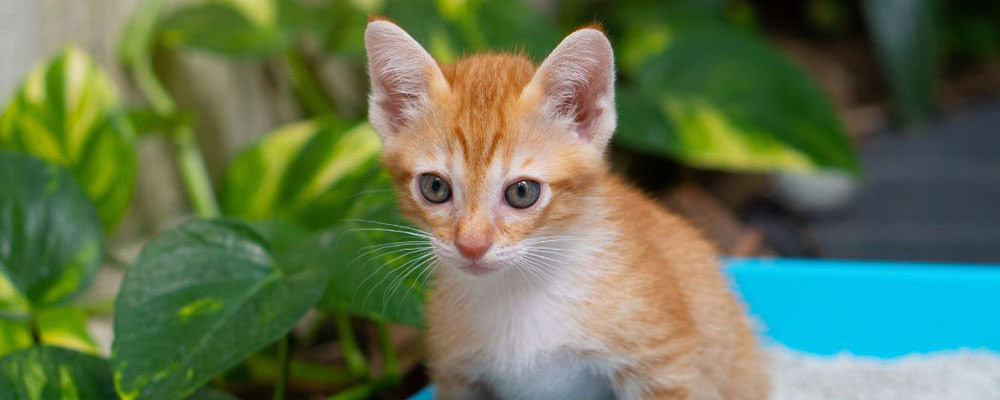
Understanding kitten litter training
Effective litter training involves understanding your kitten’s natural instincts and creating a supportive environment for learning. As your kitten grows into using its litter box consistently, you may encounter challenges, including your kitten’s resistance to certain litter, types of boxes and their placement, and occasional accidents.
By following the steps outlined in this guide, including recognising your kitten’s natural inclinations, introducing a litter box early, maintaining cleanliness, and reinforcing positive habits, you can ensure that your kitten adopts the right habits over time.
6 Steps for litter training your kitten successfully
Litter training a kitten is a process that requires commitment and understanding, and it involves specific steps that cater to the needs of a cat at the start of their fundamental development.
Just like house training or general kitten training, litter training involves introducing your new feline friend to a series of structured and consistent routines to foster the development of good habits.
Below, we outline 6 key steps to follow when litter training your kitten, including selecting the right litter box, choosing the appropriate litter, and picking the right location for your litter box.
Let us help you prepare for litter training your kitten successfully.
Step 1: Finding the right litter box for your kitten
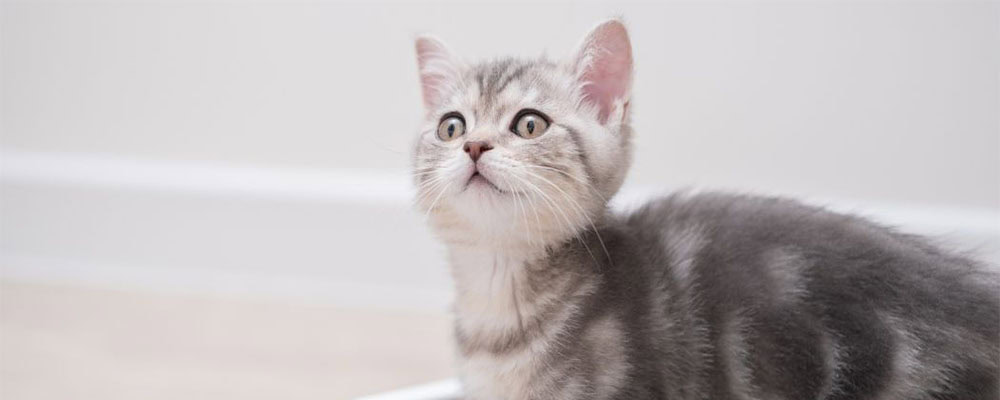
Choosing the right litter box is a fundamental first step in litter training your kitten, especially in homes with other cats. The size, style, and accessibility of the litter box can significantly impact your kitten’s willingness to use it. It’s crucial to select a box that is easy for your kitten to enter and exit, particularly during their younger, more formative weeks.
For households with multiple cats, the general rule is to have one litter box per cat plus one extra. This ensures that each cat has its own space, reducing conflicts and promoting good litter habits across all pets. Consider litter boxes with low sides for younger kittens to ensure easy access. As they grow, you may need to upgrade to a larger size to accommodate their growth.
An uncovered box is recommended to avoid any cat feeling trapped or ambushed by other cats. Cats like to be able to see if they are under threat while they are using the litter tray. In general an uncovered box also offers kittens more space and freedom to roam around.
Selecting the appropriate litter box involves considering your kitten’s needs and the dynamics of your existing pet family. This thoughtful approach sets the foundation for your kitten’s litter training journey. By choosing wisely and adjusting your setup and approach as needed, you ensure a smoother training process for your kitten and create harmony among all your cats.
Step 2. Choosing the appropriate litter for the litter box
Selecting the right type of cat litter is as crucial as choosing the litter box itself, as it directly affects how comfortably a kitten adapts to using it. The litter you choose must be kitten-friendly, taking into account factors such as odour control, texture, and dust levels, which can all influence your kitten’s willingness to use the litter box.
The type of litter used can influence both kittens’ and adult cats’ toilet time.
For kittens, it’s generally recommended to use a fine-grained, unscented, non-clumping litter. This type of litter, being non-clumping, is safer in case of ingestion, which can be harmful and is also easier on their delicate paws. As very young kittens are more likely to taste their litter during their exploratory phase, using a non-toxic, edible, or digestible form of litter, such as recycled paper, can prevent health issues. As they mature and their habits solidify, you may gradually transition to a clumping litter if preferred, for example, adult cats might prefer clumping litter for its ease of use and cleanliness.
Here are a few popular types of kitty litter available in South Africa:
- Clumping Litter: Clumping litters, made of clay materials, are highly absorbent and easy to scoop, making it a favourite for easy cleanup.
- Silica Gel Litter: Offers excellent odour control and minimal dust, ideal for kittens sensitive to dusty environments.
- Recycled Paper Litter: Dust-free with softer textures, suitable for kittens with allergies or those recovering from surgery.
- Wood or Pine Pellet Litter: Natural odour control with minimal dust; however, some kittens may take time to adjust to the larger pellet size.
- Unscented Litter: This is ideal for kittens who may be sensitive to fragrances. Unscented litter provides the same benefits as other litters without the added scents that can deter a kitten from using its box.
Introduce your chosen litter by placing your kitten in the litter box after meals and naps to encourage use. Consistency in the type of cat litter and cleaning the litter box regularly helps reinforce good litter box habits. Remember, selecting the right litter is key to ensuring your kitten’s comfort and health, and it may take trying a few types to find the one that works best for your feline friend.
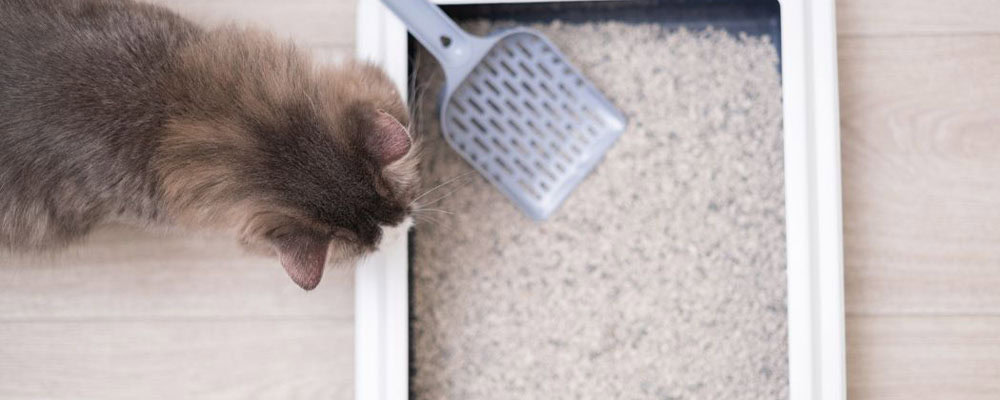
Step 3: Picking the right place for your kitten’s litter box
Choosing the ideal location for your kitten’s litter box is crucial for successful litter training. The placement influences how comfortably and consistently your kitten will use it. It’s essential to select a spot that aligns with your kitten’s need for privacy and ease of access.
Select a quiet and private location away from high-traffic areas in your home to minimise disturbances. Kittens require a comfortable environment for elimination, so avoid areas that are noisy or frequently traversed by family members and other pets. Additionally, ensure the location is always accessible, allowing your kitten to reach it without any obstacles.
Once you’ve chosen a place, ensure the litter box remains in the same spot as much as possible. Frequent changes can confuse your kitten and may lead to accidents or avoidance behaviours. If the initial spot proves unsuitable—perhaps due to noise during certain times of the day—moving the litter box to a more appropriate location might be necessary.
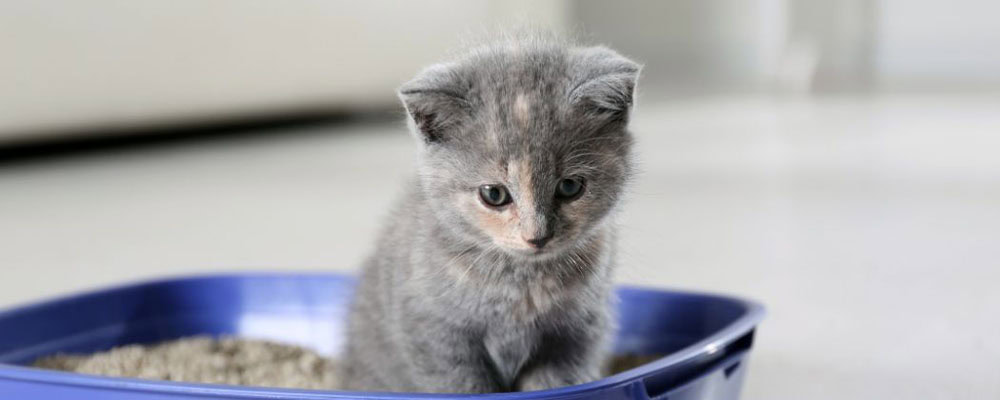
Step 4: Providing a positive litter box experience & reward-based training
Creating a welcoming litter box environment and introducing reward-based training are key factors in encouraging your kitten’s proper litter habits. Each successful use of the litter box should be met with immediate positive feedback, such as gentle strokes, verbal praise, or a small treat. This reinforces good behaviour at the moment it occurs, making the rewards timely and meaningful to your kitten.
Keep the litter tray clean to ensure it remains inviting. Cats are naturally inclined toward cleanliness, and a dirty litter box might deter them from using it. Regularly scoop and change the litter according to its type, manufacturer instructions and your kitten’s preference. This maintenance helps prevent odours and maintains a hygienic environment.
Moreover, consistency in how household members interact with the litter box and the kitten is crucial. Everyone should be aware of the importance of maintaining cleanliness and providing consistent positive reinforcement and encouragement. Avoid relocating the litter box unless absolutely necessary, as changes can disrupt your kitten’s routine and comfort.
By focusing on creating a positive environment and implementing systematic rewards for desired behaviour, you enhance your kitten’s comfort and willingness to use the litter box, setting the stage for successful and lasting litter habits.
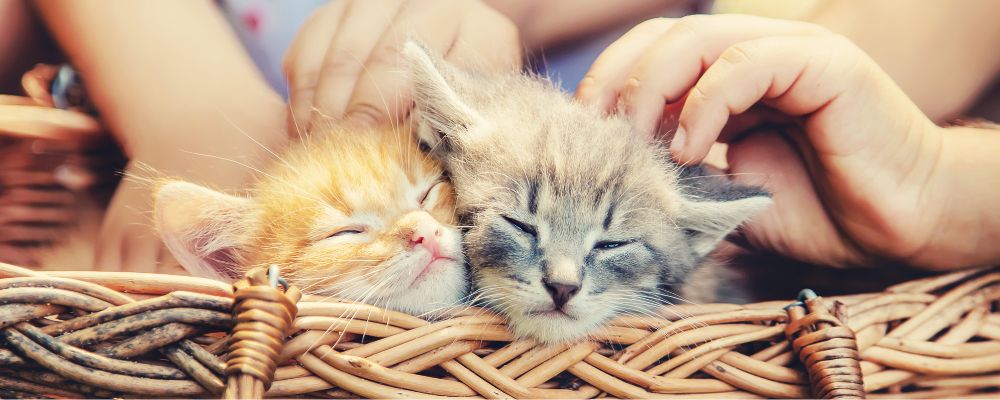
Step 5: Monitoring your litter training efforts and adjusting
Monitoring your kitten’s behaviour during litter training is critical to understanding their preferences and making necessary adjustments. Pay close attention to how your kitten interacts with the litter box and the type of litter used. This observation will help you discern their comfort levels and preferences.
Kittens may show signs of dissatisfaction with their litter by avoiding the box, attempting to dig elsewhere, or showing distress while using the box. Such behaviours indicate a need for adjustments, whether in the type of litter, the box’s cleanliness, or its location. Ensuring the litter box is always clean is essential, as kittens are particularly sensitive to unhygienic conditions.
Adjustments may also include changing the litter type if your kitten shows a preference for a different texture or odour control level. If your kitten seems to avoid the box due to its location, moving it to a quieter, more secluded area might be necessary. Additionally, if you notice your kitten has grown significantly, consider upgrading to a larger box to accommodate their size and ensure continued comfort.
By staying attentive and responsive to your kitten’s needs and behaviours, you can make the litter training process as smooth and stress-free as possible. Over time, this careful monitoring and willingness to adjust will help establish consistent and positive litter box habits, ensuring your kitten’s health and happiness.
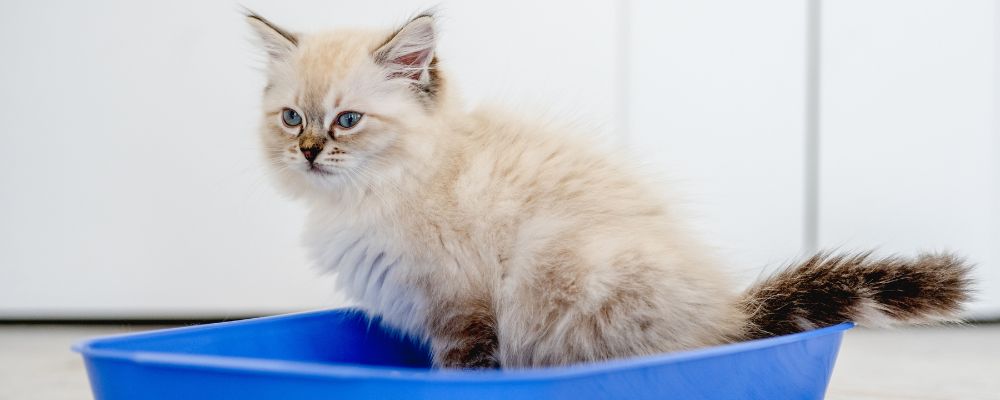
Step 6: Managing indoor accidents with understanding
Despite your best efforts in litter training, indoor accidents with your kitten are bound to happen, particularly in the early stages. It’s essential to handle these incidents with calmness and understanding. When your kitten has an accident outside the litter box, it’s not an act of defiance; rather, it usually indicates that it couldn’t reach the box in time or is still learning what is expected.
If you catch your kitten in the act, gently interrupt them without showing anger or frustration, and immediately take them to their litter box. This helps reinforce the correct behaviour without creating fear or anxiety. If you discover an accident after it has happened, simply clean it up thoroughly and ensure the litter box is more accessible and inviting. Punishing your kitten after the fact is ineffective and can lead to stress that hampers their learning.
Thorough cleaning is essential to prevent your kitten from using the same inappropriate spot again. Use an enzymatic cleaner specifically designed to neutralise pet odours, which helps remove the scent and discourages repeat marking.
Patience and consistency are crucial throughout the litter training process. Remember, each kitten learns at its own pace. With your understanding and diligent follow-up to the steps outlined, your kitten will gradually adopt a consistent routine and learn to use the litter box reliably.
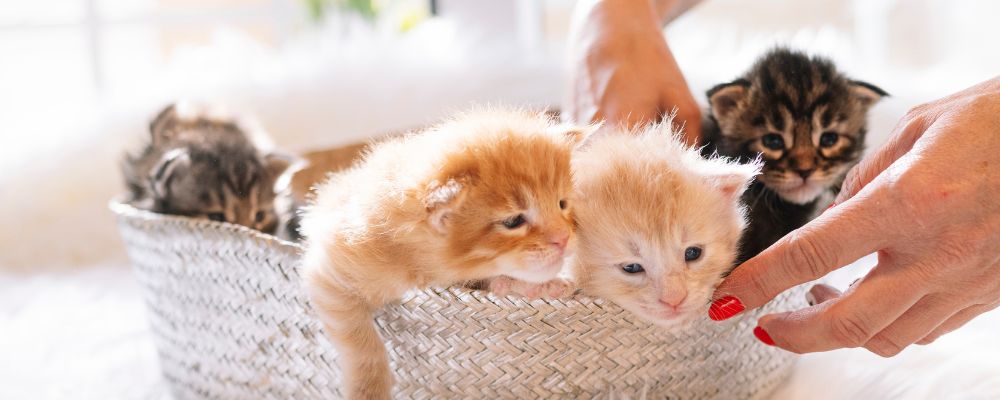
How long does it take to litter train a kitten?
Kittens need to go for wellness checks every 4 weeks, when they have their vaccinations at their vet. This is the time to discuss their urinating progress with the vet and raise any concerns. Litter training typically takes around 4 weeks for a kitten. Some kittens master it sooner, and some take a little bit longer. Go to your vet if not trained by 12 weeks. Then, if there are any signs of any regression of their toileting abilities must be raised with the vet too. Any signs of blood in urine, struggling to pass urine or stool, crying in pain when urinating or non-productive straining must be seen by the vet.
The timeline for training can vary based on factors such as the kitten’s age when training begins, their individual personality, and the consistency of the training approach.
When can you start litter training a kitten?
You can start litter training kittens from when you get them, usually at 6 weeks or after.
This is an ideal time to begin litter training as they often instinctively seek to bury their waste even at this young age. Introducing a kitten to a litter box as soon as they start showing these natural tendencies ensures that they adopt good habits early, making the training process smoother for both the kitten and the owner.
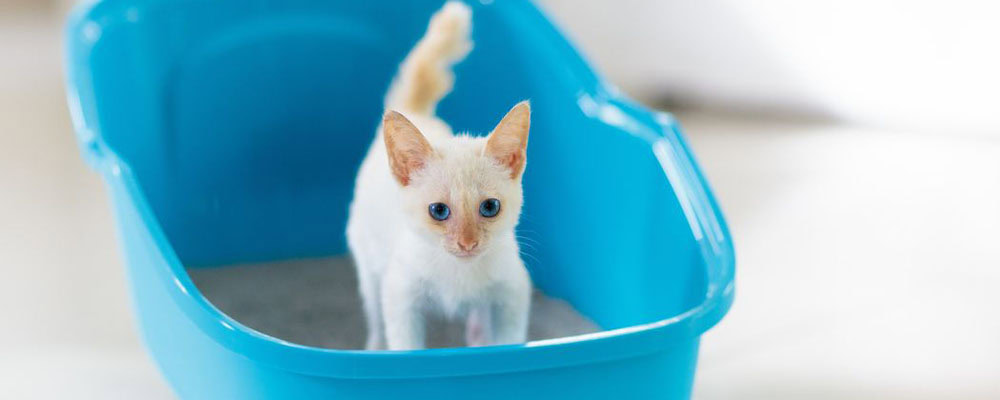
Final thoughts on litter training your kitten
In this guide, we’ve explored the key steps to successfully litter train your kitten, from selecting the right litter box to choosing suitable litter and establishing the best location for the box.
We’ve discussed the importance of creating a positive litter box environment, the advantages of reward-based training, and the need for monitoring and adjusting your approach based on your kitten’s behaviour and preferences.
Each step is designed to build upon the last, forming an easy-to-follow framework to help your kitten understand where and when it’s appropriate to use its litter box. Regular litter box cleaning, coupled with consistent reinforcement of good habits, plays a pivotal role in this process.
Remember, while some kittens might quickly adapt to using the litter box, others may take a bit longer. The key is to remain patient and positive, providing consistent guidance and support. As you and your kitten navigate this learning curve together, the efforts you invest in now will establish a foundation for a well-trained adult cat.
For those considering adding a feline member to your family, you may find our post on how to adopt a cat or dog in South Africa valuable. Our blog also features helpful content for new and prospective pet owners, including winter pet safety tips, steps to help you choose the right cattery before going away, a list of ten charming catteries in Cape Town and much more.
If you’re also considering dog adoption, you might enjoy reading about how to potty train your puppy in a few simple steps or our helpful steps for taking care of a puppy.
As you become more comfortable with litter training and daily care, it’s important to consider the broader aspects of your kitten’s health and safety. With that in mind, let’s explore how MediPet can support your journey in ensuring your kitten’s well-being.
At MediPet, we specialise in comprehensive, transparent, and genuine insurance cover for cats and dogs. Our plans include options for accidents, illnesses, and even pre-existing conditions, depending on your needs & budget. We also offer optional add-ons like routine care, benefit boosters, and ongoing chronic care support plans tailored to meet the needs of your beloved pets.
Learn more about MediPet and why we are the right choice for your pet insurance. Compare our plans, or receive an obligation-free quote online in just seconds today.
Medipet Animal Health Insurance Brokers (Pty) Ltd (MediPet) (FSP Licence No: 15491) is underwritten by Renasa licensed non-life insurer & FSP.


